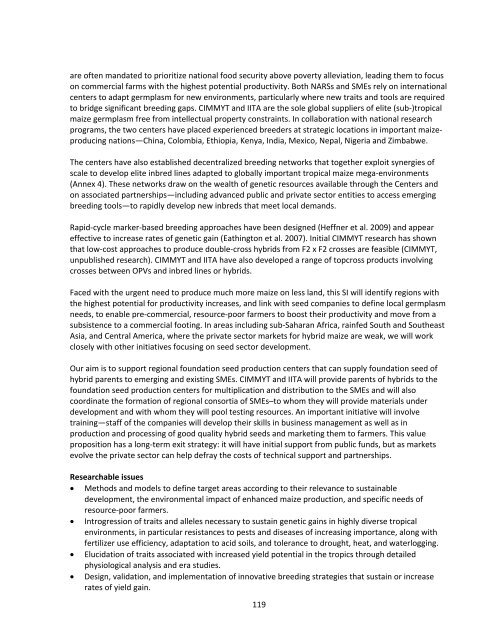Download - Maize
Download - Maize
Download - Maize
Create successful ePaper yourself
Turn your PDF publications into a flip-book with our unique Google optimized e-Paper software.
are often mandated to prioritize national food security above poverty alleviation, leading them to focus<br />
on commercial farms with the highest potential productivity. Both NARSs and SMEs rely on international<br />
centers to adapt germplasm for new environments, particularly where new traits and tools are required<br />
to bridge significant breeding gaps. CIMMYT and IITA are the sole global suppliers of elite (sub‐)tropical<br />
maize germplasm free from intellectual property constraints. In collaboration with national research<br />
programs, the two centers have placed experienced breeders at strategic locations in important maizeproducing<br />
nations—China, Colombia, Ethiopia, Kenya, India, Mexico, Nepal, Nigeria and Zimbabwe.<br />
The centers have also established decentralized breeding networks that together exploit synergies of<br />
scale to develop elite inbred lines adapted to globally important tropical maize mega‐environments<br />
(Annex 4). These networks draw on the wealth of genetic resources available through the Centers and<br />
on associated partnerships—including advanced public and private sector entities to access emerging<br />
breeding tools—to rapidly develop new inbreds that meet local demands.<br />
Rapid‐cycle marker‐based breeding approaches have been designed (Heffner et al. 2009) and appear<br />
effective to increase rates of genetic gain (Eathington et al. 2007). Initial CIMMYT research has shown<br />
that low‐cost approaches to produce double‐cross hybrids from F2 x F2 crosses are feasible (CIMMYT,<br />
unpublished research). CIMMYT and IITA have also developed a range of topcross products involving<br />
crosses between OPVs and inbred lines or hybrids.<br />
Faced with the urgent need to produce much more maize on less land, this SI will identify regions with<br />
the highest potential for productivity increases, and link with seed companies to define local germplasm<br />
needs, to enable pre‐commercial, resource‐poor farmers to boost their productivity and move from a<br />
subsistence to a commercial footing. In areas including sub‐Saharan Africa, rainfed South and Southeast<br />
Asia, and Central America, where the private sector markets for hybrid maize are weak, we will work<br />
closely with other initiatives focusing on seed sector development.<br />
Our aim is to support regional foundation seed production centers that can supply foundation seed of<br />
hybrid parents to emerging and existing SMEs. CIMMYT and IITA will provide parents of hybrids to the<br />
foundation seed production centers for multiplication and distribution to the SMEs and will also<br />
coordinate the formation of regional consortia of SMEs–to whom they will provide materials under<br />
development and with whom they will pool testing resources. An important initiative will involve<br />
training—staff of the companies will develop their skills in business management as well as in<br />
production and processing of good quality hybrid seeds and marketing them to farmers. This value<br />
proposition has a long‐term exit strategy: it will have initial support from public funds, but as markets<br />
evolve the private sector can help defray the costs of technical support and partnerships.<br />
Researchable issues<br />
Methods and models to define target areas according to their relevance to sustainable<br />
development, the environmental impact of enhanced maize production, and specific needs of<br />
resource‐poor farmers.<br />
Introgression of traits and alleles necessary to sustain genetic gains in highly diverse tropical<br />
environments, in particular resistances to pests and diseases of increasing importance, along with<br />
fertilizer use efficiency, adaptation to acid soils, and tolerance to drought, heat, and waterlogging.<br />
Elucidation of traits associated with increased yield potential in the tropics through detailed<br />
physiological analysis and era studies.<br />
Design, validation, and implementation of innovative breeding strategies that sustain or increase<br />
rates of yield gain.<br />
119

















